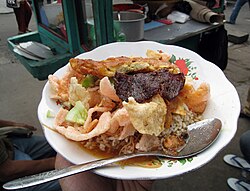Nasi ulam
 | |
| Course | Main course |
|---|---|
| Place of origin | Indonesia[1] |
| Region or state | Jakarta[2] |
| Associatedcuisine | Indonesia,Malaysia,Singaporeand SouthernThailand[3] |
| Main ingredients | Steamedricedish mixed with various herbs |
| Variations | Rich variations across the respective region |
Nasi ulamis a traditionalIndonesiandish of steamedrice(nasi) served with various herbs and vegetables (ulam).[4]
The herbs used are mostly the leaves ofpegagan(Centella asiatica), though they can also be replaced withkemangi(lemon basil), vegetables, and spices, accompanied with various side dishes.[2]This dish is a feature ofBetawi[2]andMalay cuisinewith many variations and is commonly found inIndonesia,Malaysia,Singapore,and southernThailand.Nasi ulam is often served withsambalchilli paste.
History
[edit]Nasi ulam is a typicalBetawimixed rice. Nasi ulam is a cross of several culinary cultures that influence the variant of the nasi ulam and its side dishes. Some say[who?]that white rice topped with coconut serundeng (ulam) and peanuts is an Indian influence. In Indonesia, Nasi Ulam is not only found in Jakarta but alsoSumatraandBali.UlaminBetawi languageis the name forserundengfromgrated coconut,which when stirred with hot white rice will bring out a savory and slightly spicy taste on the tongue.
The history of Nasi Ulam comes fromTangerang,Banten.Unfortunately, this dish is rarely known by the surrounding community and is more associated with cuisine from Jakarta. This is because, in the past, a large number of Nasi Ulam traders from Tangerang brought the dish toGlodok,Jakarta. The cuisine was enjoyed by the local community, particularlyChinese Indonesians.
Not all Betawi people in Jakarta are familiar with all variations of Nasi Ulam, both wet (basah) and dry (kering).Wetulam is only known among the Cina Benteng, Petak Sembilan, kawasan Pecinan, Tanjung Priok, Kemayoran, Matraman, dan Senen. Meanwhile,driedulam is known in the Tebet, Kayumanis, and Mester Jatinegara areas. Betawi people usually eat rice ulam in the morning as one of the breakfast menus.[5]
Variants
[edit]Indonesia
[edit]In Indonesia,nasi ulamcan be found inBetawi(native Jakartans) cuisine[1]as well asBaliand SumatranMalay.[6]
In Jakarta there are two types ofnasi ulam,the wet (soupy)nasi ulamof northern and central Jakarta, and dry one of southern Jakarta. In Indonesia, nasi ulam usually spiced withkemangiherb, chili, sliced cucumber and sprinkled with peanuts granule andserundeng(grated and sauteed coconut). An array of other additional dishes are often added on top ofnasi ulam,such asdendeng(beef jerky),telur dadar(omelette),perkedel(mashed potato fritter), friedtofuortempeh,andkrupuk.[7]
Malaysia
[edit]Nasi ulam in Malaysia consist of cold boiled rice that is mixed with shredded herbs such asdaun kaduk(wild pepper leaf),pucuk gajus(cashew leaf shoots), onions etc.Kerisikand other spices are also added. Sometimes shredded fried fish is mixed in. This version is common in northwest Peninsular Malaysia. A type of nasi ulam in northeast Peninsular Malaysia, in which the rice is dyed blue, is callednasi kerabu.
See also
[edit]- Ulam (salad)
- Nasi bogana
- Nasi campur
- Nasi goreng
- Nasi kebuli
- Nasi kerabu
- Nasi kucing
- Nasi kuning
- Nasi lemak
- Nasi liwet
- Nasi pecel
- Nasi tim
- Nasi uduk
References
[edit]- ^abRizky Tyas Febriani."Nasi Ulam Betawi".warisanbudaya.kemdikbud.go.id(in Indonesian).RetrievedSeptember 9,2020.
- ^abc"Where to go for authentic Betawi cuisine".The Jakarta Post.RetrievedSeptember 6,2020.
- ^"Nasi ulam, Infopedia".eresources.nlb.gov.sg.RetrievedSeptember 6,2020.
- ^"Perpaduan Kultur Dalam Seporsi Nasi Ulam Betawi",Food Detik
- ^"Nasi Ulam, Kuliner",encyclopedia.jakarta-tourism
- ^Digital, Prodik (September 10, 2020)."Makanan Khas Bali di Harris Hotel Sentul City".Tempo.RetrievedSeptember 13,2020.
- ^"Perpaduan kultur dalam seporsi nasi ulam betawi".(Indonesian)
